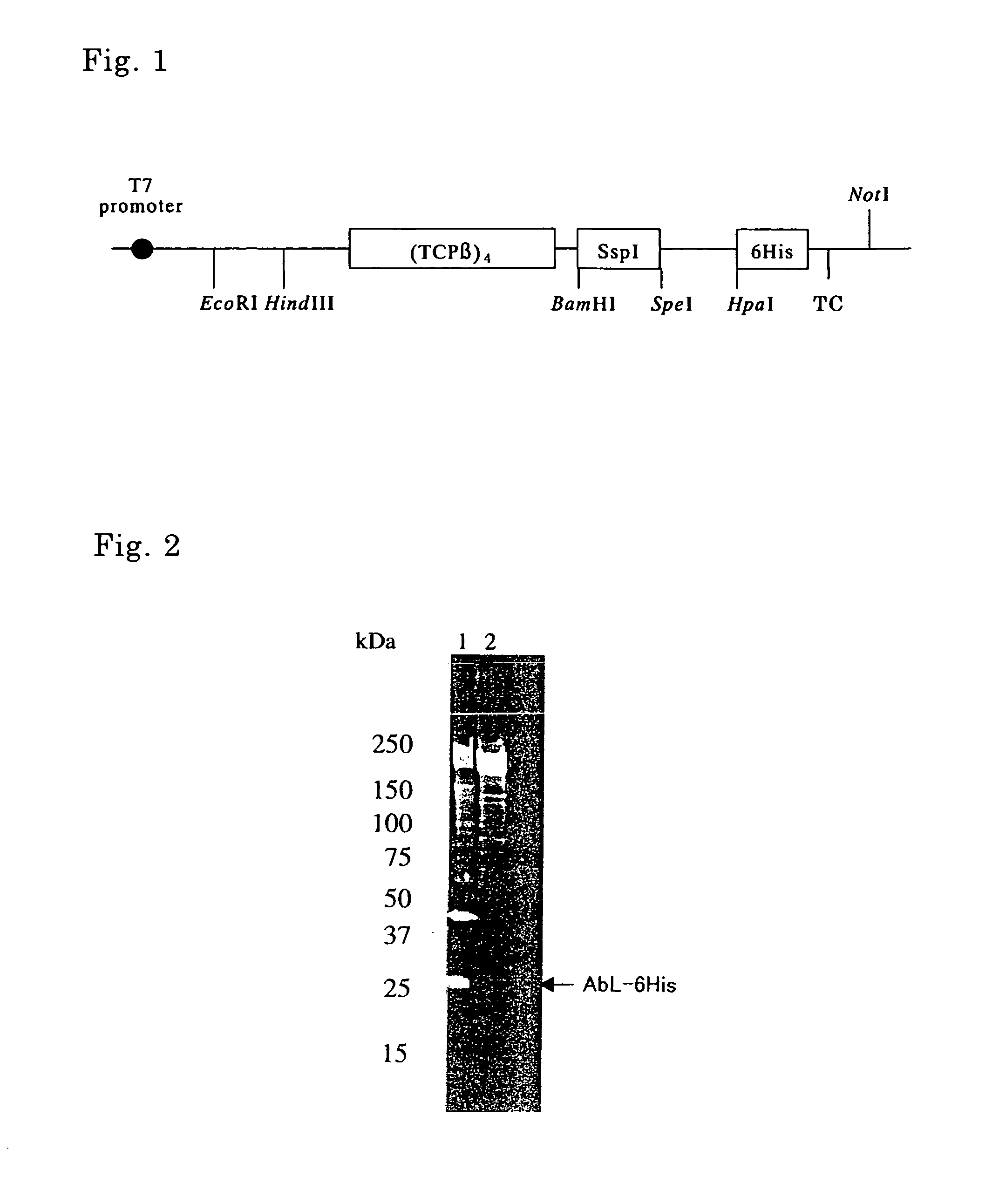Method of producing target protein, fusion protein and gene thereof, protein consisting of partial sequence of intein and gene thereof, expression vector, and transformant
a technology of fusion protein and target protein, which is applied in the direction of dna/rna fragmentation, peptides, fungi, etc., can solve the problems of difficult to obtain recombinant proteins, not all target proteins are readily obtained by these protein expression systems, and the expression level decreases. , to achieve the effect of introducing the gen
- Summary
- Abstract
- Description
- Claims
- Application Information
AI Technical Summary
Benefits of technology
Problems solved by technology
Method used
Image
Examples
example 1
1. Isolation of SspI Gene
[0119] PCR using pTWIN1 (New England Biolabs) as a template and oligonucleotides as shown in SEQ ID No. 1 and No. 2 as a primer set was carried out, thereby isolating a DNA fragment containing a gene encoding SspI. The nucleotide sequence and the amino acid sequence corresponding thereto are shown in SEQ ID No. 3 and only the amino acid sequence is shown in SEQ ID No. 4. Herein, SspI is a modified intein (C-intein) obtained by removal of the endonuclease region of DnaB helicase intein derived from a cyanobacterium, Synechocystis sp. strain PCC 6803 and by substitution of the amino acid of the N-terminal thereof to an alanine.
2. Construction of an Archaeal Chaperonin Subunit Linkage Expression System
[0120] Genomic DNA was extracted from Thermococcus strain KS-1 (JCM No. 11816). A DNA fragment containing a chaperonin β subunit (hereinafter referred to as “TCPβ”) gene as shown in SEQ ID No. 7 was isolated by PCR using the genomic DNA as a template and olig...
example 2
1. Expression and Cleavage of a Hepatitis C Virus
[0128] Long-chain DNA synthesis prepared a DNA fragment containing a hepatitis C virus core antigen (HCc) gene as shown in SEQ ID No. 11. An expression vector pETDH(TCPβ)4I·HCc synthesizing a fusion protein composed of (TCPβ)4, SspI, and HCc was constructed by introduction of the DNA fragment in the expression vector pETDH(TCPβ)4I in the same way as Example 1. The obtained expression vector pETDH(TCPβ)4I·HCc was introduced into E. coli strain BL21 (DE3), whereby a transformant was obtained. The transformant was cultured in the same way as Example 1 to give a supernatant of cell lysate.
example 3
1. Isolation of a Gene Encoding Modified SspI That Cleaves Only the N-Terminus
[0132] PCR using pTWIN1 (New England Biolabs) as a template and oligonucleotides as shown in SEQ ID No. 12 and No. 13 as a primer set was carried out, thereby isolating a DNA fragment containing a gene encoding SspI as shown in SEQ ID No. 6 that was modified so as to cleave only the N-terminus (hereinafter referred to as “NSspI”). More specifically, NSspI is a modified intein (N-intein) obtained by removal of the endonuclease region of DnaB helicase intein derived from a cyanobacterium, Synechocystis sp. strain PCC 6803 and by substitution of the amino acid of the C-terminal thereof to an alanine.
2. Construction of E. coli Chaperonin Subunit Linkage Expression System
[0133] Genomic DNA was extracted from E. coli strain HMS174 (Novagen). A DNA fragment containing GroEL subunit gene as shown in SEQ ID No. 17 was isolated by PCR using the genomic DNA as a template and oligonucleotides as shown in SEQ ID N...
PUM
| Property | Measurement | Unit |
|---|---|---|
| temperature | aaaaa | aaaaa |
| pH | aaaaa | aaaaa |
| height | aaaaa | aaaaa |
Abstract
Description
Claims
Application Information
 Login to View More
Login to View More - Generate Ideas
- Intellectual Property
- Life Sciences
- Materials
- Tech Scout
- Unparalleled Data Quality
- Higher Quality Content
- 60% Fewer Hallucinations
Browse by: Latest US Patents, China's latest patents, Technical Efficacy Thesaurus, Application Domain, Technology Topic, Popular Technical Reports.
© 2025 PatSnap. All rights reserved.Legal|Privacy policy|Modern Slavery Act Transparency Statement|Sitemap|About US| Contact US: help@patsnap.com



